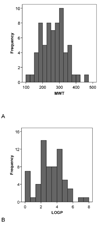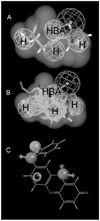Molecular characterization of CYP2B6 substrates
- PMID: 18537573
- PMCID: PMC2426921
- DOI: 10.2174/138920008784746346
Molecular characterization of CYP2B6 substrates
Abstract
CYP2B6 has not been as fully characterized at the molecular level as other members of the human cytochrome P450 family. As more widely used in vitro probes for characterizing the involvement of this enzyme in the metabolism of xenobiotics have become available, the number of molecules identified as CYP2B6 substrates has increased. In this study we have analyzed the available kinetic data generated by multiple laboratories with human recombinant expressed CYP2B6 and along with calculated molecular properties derived from the ChemSpider database, we have determined the molecular features that appear to be important for CYP2B6 substrates. In addition we have applied 2D and 3D QSAR methods to generate predictive pharmacophore and 2D models. For 28 molecules with K(m) data, the molecular weight (mean +/- SD) is 253.78+/-74.03, ACD/logP is 2.68+/-1.51, LogD(pH 5.5) is 1.51+/-1.43, LogD(pH 7.4) is 2.02+/-1.25, hydrogen bond donor (HBD) count is 0.57 +/-0.57, hydrogen bond acceptor (HBA) count is 2.57+/-1.37, rotatable bonds is 3.50+/-2.71 and total polar surface area (TPSA) is 27.63+/-19.42. A second set of 15 molecules without K(m) data possessed similar mean molecular property values. These properties are comparable to those of a set of 21 molecules used in a previous pharmacophore modeling study (Ekins et al., J Pharmacol Exp Ther 288 (1), 21-29, 1999). Only the LogD and HBD values were statistically significantly different between these different datasets. We have shown that CYP2B6 substrates are generally small hydrophobic molecules that are frequently central nervous system active, which may be important for drug discovery research.
Figures






Similar articles
-
Combined three-dimensional quantitative structure-activity relationship analysis of cytochrome P450 2B6 substrates and protein homology modeling.Drug Metab Dispos. 2002 Jan;30(1):86-95. doi: 10.1124/dmd.30.1.86. Drug Metab Dispos. 2002. PMID: 11744616
-
Substrate specificity, regulation, and polymorphism of human cytochrome P450 2B6.Curr Drug Metab. 2009 Sep;10(7):730-53. doi: 10.2174/138920009789895534. Curr Drug Metab. 2009. PMID: 19702527 Review.
-
Three-dimensional quantitative structure activity relationship analyses of substrates for CYP2B6.J Pharmacol Exp Ther. 1999 Jan;288(1):21-9. J Pharmacol Exp Ther. 1999. PMID: 9862748
-
High-throughput screening assays for CYP2B6 metabolism and inhibition using fluorogenic vivid substrates.AAPS PharmSci. 2003;5(2):E18. doi: 10.1208/ps050218. AAPS PharmSci. 2003. PMID: 12866948 Free PMC article.
-
The role of CYP2B6 in human xenobiotic metabolism.Drug Metab Rev. 1999 Aug;31(3):719-54. doi: 10.1081/dmr-100101942. Drug Metab Rev. 1999. PMID: 10461547 Review. No abstract available.
Cited by
-
Halogen Substitution Influences Ketamine Metabolism by Cytochrome P450 2B6: In Vitro and Computational Approaches.Mol Pharm. 2019 Feb 4;16(2):898-906. doi: 10.1021/acs.molpharmaceut.8b01214. Epub 2019 Jan 10. Mol Pharm. 2019. PMID: 30589555 Free PMC article.
-
Monocrotophos induces the expression and activity of xenobiotic metabolizing enzymes in pre-sensitized cultured human brain cells.PLoS One. 2014 Mar 24;9(3):e91946. doi: 10.1371/journal.pone.0091946. eCollection 2014. PLoS One. 2014. Retraction in: PLoS One. 2019 Mar 15;14(3):e0214164. doi: 10.1371/journal.pone.0214164. PMID: 24663500 Free PMC article. Retracted.
-
Use of Ca-alginate immobilized Pseudomonas aeruginosa for repeated batch and continuous degradation of Endosulfan.3 Biotech. 2016 Dec;6(2):124. doi: 10.1007/s13205-016-0438-2. Epub 2016 Jun 6. 3 Biotech. 2016. PMID: 28330200 Free PMC article.
-
Natural Products Inhibition of Cytochrome P450 2B6 Activity and Methadone Metabolism.Drug Metab Dispos. 2024 Feb 14;52(3):252-265. doi: 10.1124/dmd.123.001578. Drug Metab Dispos. 2024. PMID: 38135504 Free PMC article.
-
Impact of nicotine metabolism on nicotine's pharmacological effects and behavioral responses: insights from a Cyp2a(4/5)bgs-null mouse.J Pharmacol Exp Ther. 2013 Dec;347(3):746-54. doi: 10.1124/jpet.113.208256. Epub 2013 Sep 17. J Pharmacol Exp Ther. 2013. PMID: 24045421 Free PMC article.
References
-
- Kumagai J, Fujimura T, Takahashi S, Urano T, Ogushi T, Horie-Inoue K, Ouchi Y, Kitamura T, Muramatsu M, Blumberg B, Inoue S. Prostate. 2007;67:1029–1037. - PubMed
-
- Ekins S, VandenBranden M, Ring BJ, Wrighton SA. Pharmacogenetics. 1997;7:165–179. - PubMed
-
- Ekins S, Vandenbranden M, Ring BJ, Gillespie JS, Yang TJ, Gelboin HV, Wrighton SA. J Pharmacol Exp Ther. 1998;286:1253–1259. - PubMed
-
- Ekins S, Wrighton SA. Drug Metab Rev. 1999;31:719–754. - PubMed
-
- Ekins S, Bravi G, Ring BJ, Gillespie TA, Gillespie JS, Vandenbranden M, Wrighton SA, Wikel JH. J Pharmacol Exp Ther. 288:21–29. - PubMed
Publication types
MeSH terms
Substances
Grants and funding
LinkOut - more resources
Full Text Sources
Medical
Research Materials
Miscellaneous

